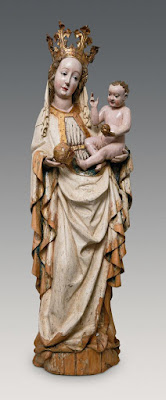 |
| Niclaus Gerhaert: Self portrait (?), c 1463 Musée de l'Oeuvre Notre-Dame, Strasbourg |
The Liebieghaus in Frankfurt dedicated a monographic exhibition to the late Gothic sculptor Niclaus Gerhaert of Leiden. Alongside Hans Multscher, Gerhaert is regarded as the most important artistic character developing the naturalistic formal language of Late Gothic sculpture. His career corresponds to the spread of artistic ideas from west to east: although it is not known whether he was actually born in Leiden (given as his origin in later sources), but he was likely trained in the artistic milieu of the Southern Netherlands, then in the 1460s worked on the eastern part of the Holy Roman Empire - more precisely in Strassburg - and was finally invited by Emperor Frederick III to Vienna and Wiener Neustadt, where he died in 1473. Although the corpus of works firmly attributed to him is rather small, his influence was enormous, and members of his workshop as well as his followers determined the development of Late Gothic sculpture in Central Europe. The art of both Veit Stoss and Tilman Riemenschneider would be unthinkable without the influence of Gerhaert.
The exhibition currently on view in Frankfurt is accompanied by a comprehensive catalogue edited by Stefan Roller. There are essays in the catalogue by a number of authors, following an introductory study by Roland Recht. This part is followed by catalogue entries, the first part of which include all the surviving works attributed to Niclaus Gerhaert (including those not in the exhibition), while the second part analyses the sculptures featured at the Frankfurt exhibition - arranged in groups of works from the environment of the master, and works showing his influence.
In the following, I would like to focus on one aspect of the subject, the influence of Gerhaert in the Kingdom of Hungary. I stated above that the sculptor was invited to Vienna by Frederick III, the most formidable opponent of Hungary's king Matthias. Gerhaert was commissioned to work on the tomb of the Emperor (in the Stephansdom of Vienna) and also on that of Queen Eleonore of Portugal (in Wiener Neustadt). Work on the Vienna tomb was likely disrupted in 1473, at the death of the artist, and again in 1485, when the troops of Matthias moved in to occupy the town. By that time the tombstone was moved to Wiener Neustadt, only to be returned to Vienna in 1493, so three years after the death of King Matthias. The tomb was not completed until 1513. There are few other works firmly attributed to Gerhaert from his Viennese period: first among them is the tomb of Queen Eleonore at Wiener Neustadt, wife of Frederick III, who passed away in 1467 - at the time the master was invited by the Emperor. In Wiener Neustadt, there is also a painted limestone statue of the Man of Sorrows at the former Cathedral (the Diocese was established by Frederick in 1469). Apart from these stone monuments, there a few wooden statues from this period, as Niclaus Gerhaert was an equally versatile sculptor both in stone and wood. Two small statues of the Virgin in Child - one in the Metropolitan Museum, the other in private collection - round out this period of the artist.
| Head of St. John from Tájó |
In the territory of the Kingdom of Hungary, it was his works of wood which exerted a considerable influence. Stefan Roller dedicated a study to the influence of of Gerhaert in Central Europe, and two objects from Upper Hungary (the territory of modern Slovakia) are actually included in the exhibition. Altogether, four works are discussed: the Head of St. John the Baptist from Tájó (Tajov, Slovakia), the main altar of Kassa (Košice) and the Nativity group as well as a figure of the Virgin at the reading stand - both originally from the main altar of the parish church of Pozsony (Bratislava).






















